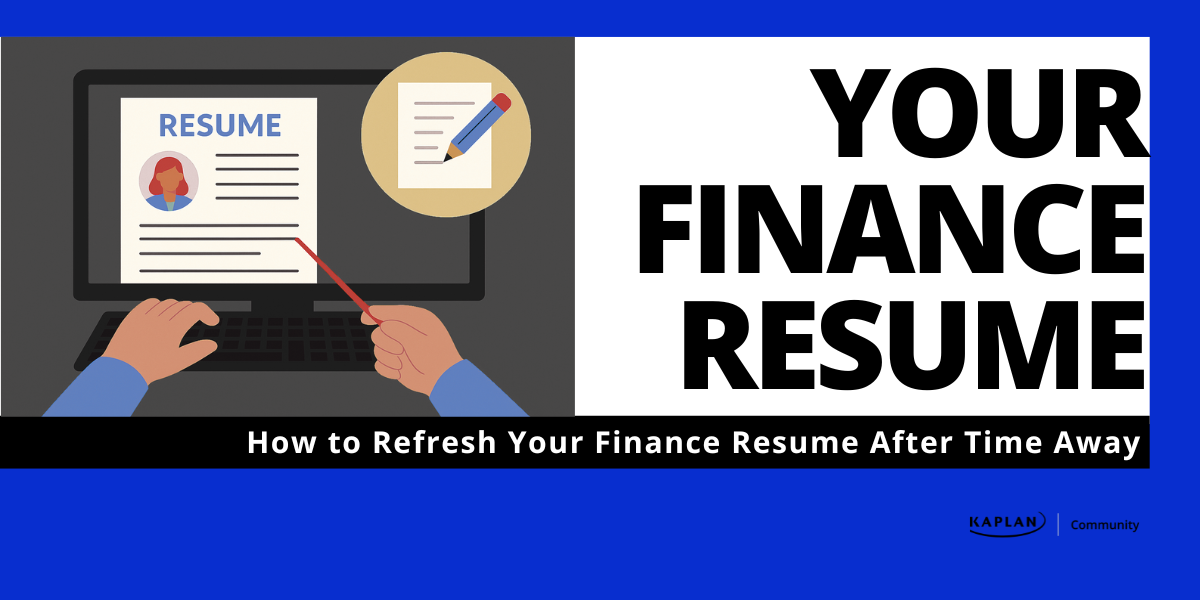How to Refresh Your Finance Resume After Time Away


Career breaks occur for many reasons: family care, health concerns, relocation, or professional burnout. The financial industry evolves rapidly, but your time away doesn't need to hold you back.
With strategic planning and the right approach, you can create a finance resume that showcases your value despite employment gaps.
Address Your Career Gap Directly
Career gaps once carried stigma, but attitudes have changed dramatically. Employers understand that career paths aren't always linear. Instead of hiding your time away, address it confidently on your resume.
- Create a dedicated section: List your career break chronologically like any other position, including dates. This transparent approach shows professionalism and prevents employers from making assumptions.
Career Break | 2021-2023 Planned sabbatical focused on family caregiving responsibilities while maintaining professional development through finance certifications and volunteer treasury work with local nonprofit organizations. |
|---|
- Show off transferable skills: Your time away likely yielded valuable skills. Did you manage complex family finances? Volunteer as a treasurer? Complete any finance courses? These experiences demonstrate your continued engagement with financial concepts.
Focus on Your Professional Story
When revitalizing your finance resume after a gap, how you frame your career narrative matters tremendously.
Structure your resume like a sandwich
Begin with your professional background and accomplishments before the break, include the career break in the middle with positive framing, and finish with what you're looking to do next.
Instead of opening with "I've been out of the workforce for three years," try: "Financial analyst with eight years of experience in investment banking and portfolio management who took a planned career break and now seeks to leverage updated skills in a dynamic asset management role."
Use a powerful summary statement. Place a concise professional summary at the top of your resume that ties together your past experience, any relevant activities during your break, and your current career goals.
Update Technical Knowledge and Skills
The financial industry constantly evolves with new regulations, technologies, and methodologies. Demonstrate that you've kept pace with these changes.
Add recent certifications. Consider earning or refreshing certifications relevant to your target role. Options include:
- Bloomberg Market Concepts
- Financial modeling courses
- Excel or data analysis certifications
- Industry-specific credentials like Series licenses
Display current technical skills. Update your skills section to include the latest tools and platforms used in finance:
- Financial modeling software
- Data visualization tools
- Industry-specific applications
- Programming languages valuable in finance (Python, R, SQL)
Stay current on industry trends: Mention your familiarity with recent regulatory changes, market developments, or analytical approaches in your summary or cover letter.
Revitalize Your Resume Format
The presentation of your resume can significantly impact how employers perceive your career gap.
Use a hybrid resume format. Combine chronological and functional elements to emphasize skills while maintaining timeline clarity. This approach lets you showcase capabilities while acknowledging your career history honestly.
Remove months from employment dates. Without being misleading, you can list just the years of employment to make gaps appear less prominent.
Financial Analyst, XYZ Investment Firm, 2015-2019 Career Break, 2019-2021 |
|---|
Finance resumes should remain clean and professional, but updating to a contemporary format signals that you're current with professional standards. Use appropriate white space, consistent formatting, and a modern (but professional) typeface.
Practical Resume Refresh Steps
Follow these concrete steps to transform your finance resume:
- Repolish your contact information and professional summary to acknowledge your break while emphasizing current career goals and including your LinkedIn profile
- Add new skills and certifications acquired during or after your break, focusing on those most relevant to your target position
- Review financial terminology to ensure you're using current industry language while quantifying past achievements with specific metrics
- Cut outdated experience older than 10-15 years unless particularly relevant, and proofread meticulously, as attention to detail remains critical in finance
Building Confidence for Your Return
Your resume represents just one part of a successful re-entry into finance. Building confidence for interviews supports your application.
- Prepare to discuss your break: Practice explaining your career gap positively, focusing on what you gained rather than apologizing for time away.
- Network strategically: Reconnect with former colleagues and expand your professional network through industry events or online forums like LinkedIn groups for finance professionals.
- Consider returnship programs: Major financial institutions increasingly offer formal programs for professionals returning after career breaks. These structured opportunities provide training, mentorship, and paths back to permanent roles.
The Financial Industry Wants Your Experience
Your previous experience remains valuable. Your knowledge of fundamental financial principles, past client relationships, and industry insights provides context that newer professionals lack.
By transparently addressing your career gap, updating your skills, and thoughtfully presenting your experience, you position yourself as a seasoned professional ready to contribute immediately. Your career break may even provide a unique perspective and resilience that enhances your value to potential employers.
With deliberate preparation and strategic resume positioning, your return to financial services can launch an exciting new chapter in your career journey.
